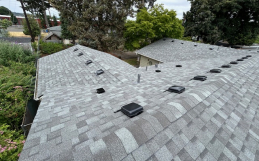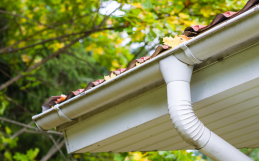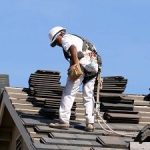A Complete Guide for Homeowners
If you’re building a home, replacing an aging roof, or simply exploring your options, you’ve probably come across the term composite roofing material. But what is composite roofing exactly? And how does it compare to other types of roofing like asphalt shingles, clay tiles, cedar shakes, or metal?
At Warner Roofing & Construction, we’ve helped countless homeowners navigate these questions with confidence. Below, we’ll walk you through everything you need to know about composite shingles, including how they’re made, their benefits, their expected lifespan, how they compare to other roofing products, and whether they’re the right option for homeowners in the Pacific Northwest.
What Is Composite Roofing?
Composite roofing refers to a class of roofing shingles made from a blend of multiple materials—usually including fiberglass, recycled plastics, asphalt, and engineered polymers. The result is a highly durable, weather-resistant, and visually appealing roofing material that’s designed to replicate the look of natural products like slate tiles, clay tiles, or wood shakes, while improving on their weaknesses.
You may also hear composite roofing called:
- Composite shingles
- Synthetic roofing
- Designer shingles (especially when styled to mimic high-end materials)
What sets composite roofing apart is its engineered structure: it’s made to be lightweight but strong, attractive but low maintenance, and versatile across a range of weather conditions.
Types of Composite Roofing
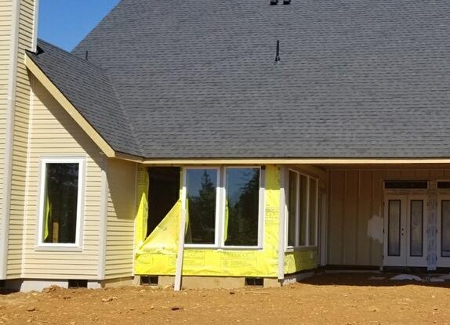 There are several types of composite roofing, each with a slightly different appearance and performance profile:
There are several types of composite roofing, each with a slightly different appearance and performance profile:
1. Composite Slate Shingles
Mimic the look of natural slate tiles but without the weight or brittleness. These are great for homeowners who want the appearance of slate without reinforcing their roof framing.
2. Composite Shake Shingles
Designed to resemble cedar shakes or wood shingles, these products offer the charm of natural wood without the same vulnerability to rot, insects, or cracking.
3. Architectural or Designer Composite Shingles
Feature layered construction for extra dimension and shadowing—ideal for high-end curb appeal. These are often used as a more attractive alternative to traditional asphalt shingles.
Each of these roofing products is available in a wide range of colors and finishes, making composite roofing one of the most versatile options for homeowners today.
Lifespan of Composite Shingles
One of the biggest advantages of composite shingles is their durability. When installed by professionals like the team at Warner Roofing, composite roofing material typically lasts 30 to 50 years—sometimes even longer.
This long lifespan is thanks to:
- Resistance to UV rays
- Toughness against high winds, rain, and hail
- Resistance to cracking, warping, and moisture penetration
- Mold, moss, and insect resistance (unlike wood shakes)
Compared to other roofing shingles:
- Asphalt shingles: 15–30 years
- Cedar shake shingles roofing: 20–30 years (with regular maintenance)
- Composite shingles: 30–50 years
- Metal roofing: 40–70 years
So while composite isn’t the absolute longest-lasting type of roofing, it delivers excellent value for the price, which makes it cost-effective, and offers far more visual customization than metal.
Maintenance and Care
Homeowners love composite roofing because it’s relatively low maintenance compared to natural materials. Here’s what you can expect:
- Annual inspection: Always check for signs of wear, blocked gutters, or debris buildup—just like with any roof.
- Cleaning: Most composite roofs don’t require frequent cleaning, but if you see algae or moss (common in the Pacific Northwest), a light wash with water and a soft brush may be needed.
- Repairs: Individual shingles can be replaced if damaged, but this is rare with composite materials.
- Color retention: Many composite products include UV inhibitors that prevent fading.
Overall, composite roofing material offers excellent long-term performance with minimal upkeep.
Pros and Cons of Composite Roofing
Pros:
- Realistic appearance: Mimics the look of premium materials
- Long lifespan: Often 30–50 years
- Low maintenance: Less work than cedar shakes or clay tiles
- Lightweight: Easier to install and doesn’t require structural reinforcement
- Fire resistance: Many products carry Class A fire ratings
- Energy efficiency: Some versions are reflective and ENERGY STAR-rated
- Weather resistance: Performs well in rain, wind, hail, and snow
Cons:
- Higher initial cost than asphalt shingles
- Not as long-lasting as metal roofing
- May not be recyclable depending on the blend
- Style limitations: While very versatile, not everyone prefers synthetic over natural materials
Knowing the pros and cons of composite helps you make an informed choice based on your goals, budget, and long-term plans for your home.
Composite vs. Cedar Shakes and Metal Roofing
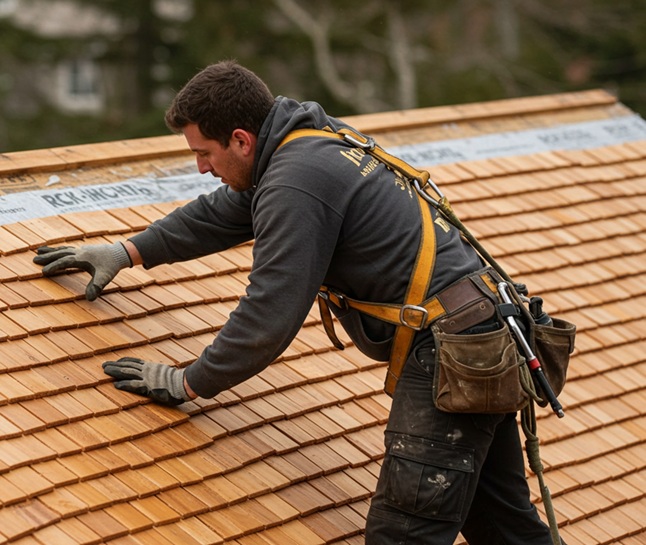 Choosing between composite, wood, and metal comes down to your priorities:
Choosing between composite, wood, and metal comes down to your priorities:
Composite vs. Cedar Shake Shingles
- Composite can mimic the look of cedar shakes without the maintenance
- Composite resists rot, insects, and UV better than natural wood shakes
- Cedar offers unmatched texture and warmth, but requires regular sealing and cleaning
Composite vs. Metal Roofing
- Metal lasts longer (40–70 years) and offers better fire protection
- Composite is quieter during rain and often more visually traditional
- Composite can be styled to match more architectural styles
At Warner Roofing, we install all of the above and can help you compare samples, costs, and expected performance to make the right choice for your home.
What to Consider Before Choosing Composite Roofing
Before moving forward with composite roofing, keep these points in mind:
- Budget: It’s more expensive than asphalt but more affordable than real slate or cedar
- HOA or neighborhood guidelines: Composite roofing may or may not be allowed depending on your area
- Climate: Composite materials are great for areas like Vancouver and Portland that experience wet seasons
- Aesthetic goals: Do you want your roof to mimic clay tiles, wood shakes, or something sleek and modern?
When in doubt, consult a professional roofer who can walk you through samples and help you make a decision that balances appearance, longevity, and cost.
FAQs About Composite Roofing
What is composite roofing made of?
Composite roofing is typically made from a blend of materials such as fiberglass, recycled plastic, asphalt, and polymers designed to mimic natural roofing materials.
How long do composite shingles last?
Most composite shingles last 30 to 50 years, depending on the brand, installation quality, and climate.
Are composite shingles better than asphalt shingles?
They offer a longer lifespan, better durability, and more style options—but they also come at a higher upfront cost.
Is composite roofing fire-resistant?
Yes, many composite shingles carry a Class A fire resistance rating, the highest available for roofing products.
Do composite roofs require a lot of maintenance?
Not at all. Unlike cedar shakes or wood shingles, composite materials are low maintenance and resist mold, insects, and warping.
Thinking About Composite Shingles? Let’s Talk.
At Warner Roofing & Construction, we’ve been helping homeowners throughout Clark County and the Portland metro area make smart roofing choices for decades. Whether you’re exploring composite material, comparing costs with other roofing options, or just want expert advice, we’re here to help.
Our team is trained in all major roofing systems—from designer shingles to metal roofing—and we believe in giving you the knowledge and options to choose what’s best for your home, not what’s easiest for us.
Contact Warner Roofing today for a free consultation and let’s find the perfect roof for your needs, your style, and your future.

